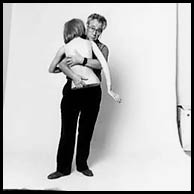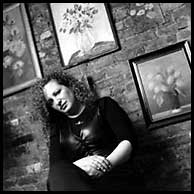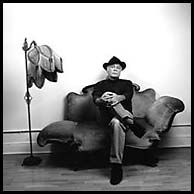| |
Interview
with Paul Waldman
(Continued
from page one)
What
kind of people are these photographers? Is there some quality or
characteristic that binds them together?
They
are individuals as we all are. Some are cautious, some passionately
intense, others whose social awareness is consuming. Each is visually
powerful. They have a charge and energy that defies explanation.
All of them catch time. They share the power of conscience and the
beauty of childlike vision. It is remarkable.
Do
you get a sense for why these photographers love photography?
The LAMPP participants range from commercial photographers to cultural
image trendsetters. These women and men are bound only by the obligation
of personal vision and an obsession to see. The project encourages
people to go to the source for answers; to ask the photographers
themselves why they love photography. The LAMPP promotes society
to engage these artists. It’s a unique opportunity. Participants
have considerable cultural and social insights. The more we see
this as an historic opportunity, the more we respond to the tenet
of the "Living" in Living American Master Photographers
Project. The purpose of the LAMPP is to direct public awareness
to the lives of these individuals.
Are
the photographers as interesting or as intense as their photographs?
There
are those photographers whose intensity is immeasurable, not in
an uncomfortable way, but in a way that, while with them, time seems
to move more quickly, finding yourself at your end before you've
felt the beginning. Only after a time as these, does the memory
catch, the experiences seem whole, and the moments make sense. The
eyes of art photographers are celestial, searching. Photojournalists
tend to have cautious, penetrating eyes. It can be like looking
into the soul of an eagle incarnated as a human being. Each participant
in the LAMPP reflects, in sometimes vastly divergent ways, the nature
of her/his vision.
 |
How
long were your shoots? Did the subjects give you much time?
LAMPP
shoots can last as long as an entire day or as short as 15 minutes.
This largely depends on the individual participant. My preference
is to have as much time as possible. I like to discuss the process
of capture or exchange of one’s personal image. Many times
it depends on how well I can fit in their busy schedules. I've got
it down pretty good and can work under the tightest time limits.
These photographers command substantial pay. I take the amount of
time given me, divide that into their day rate, and consider resulting
opportunity a small working grant.
Was
it hard to set up the shoots with these famous photographers? How
long would it usually take to set up a meeting and shooting?
The time it takes to set up a shoot depends solely on the
individual photographer. They live very active lives. Their private
time tends to be that, private. A portrait is a kind of personal
excavation. Not everyone is immediately open to the idea. Patience
has a distinct role; Persistence, equal to that of patience. Many
times establishing these relationships predate the actual participation
of a LAMPP subject. Sometimes this takes place over the course of
several years.
These opportunities depend on my ability to stay organized. I rely
heavily on my Apple G4 computer to keep track of assets, media,
releases, press, bios, etc. The project would be impossible to set
up or manage without an easy way to keep things together, not to
mention inspired.
Do
you find the photographers as comfortable in front of the lens while
you're shooting as they obviously are behind the lens shooting their
own photographs?
Jack Mitchell, a LAMPP participant, said "photographing another
photographer is always a tension convention." When a photographer
wants to be there, if they want to do it, then it is an easy and
rewarding communion. For example, with Lois Greenfield, we talked,
she shared her thoughts about the portrait, maybe it isn’t
in the photos so much as it is in the memory and the enjoyment.
Or with Allen Dutton. He said “Do you want to take it here
or on the road?” I chose the road. I hope my work is a reflection
of the respect that mutually develops between the participants and
myself. I think the beauty of the shot is ultimately measured by
this respect.
Personally, I dive from cameras. I am incredibly uncomfortable in
front of them. When I allow myself to be photographed it’s
very personal. My image is intimately mine. It’s that way even
though others might think it trivial. Not everyone looks at it in
this way. Mine is an emotional reflection. I treat other’s
images the way I would my own.
|
|
|

Elliot
Erwitt , 1992
©Paul
Waldman

Nan
Goldin , 1994
©Paul
Waldman

Eddie
Adams , 1993
©Paul
Waldman |
|





